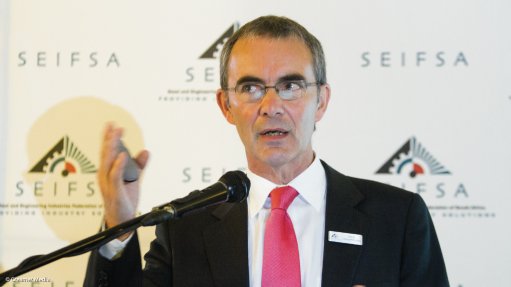
Seifsa chief economist Henk Langenhoven
Photo by: Duane Daws
The steel and engineering sector was estimated to have produced R488-billion worth of output during 2014 and added a R117-billion of value to the economy, Steel and Engineering industries Federation of Southern Africa (Seifsa) chief economist Henk Langenhoven said on Tuesday.
Speaking at the Seifsa Analysis of Anticipated Social, Political, Economic and Labour Trends seminar for 2015, he noted that employment in the sector, where 398 000 people were formally employed, was fairly stable.
“[Last year] was a disappointing year. It was expected that growth would resume after the 2% contraction during 2013 but the hope of continued domestic and international recovery at the beginning of the year faded during 2014,” he commented.
He further pointed out that this meant that production levels were still 25% to 30% lower than the sector’s 2007 peak. Employment and profitability had declined, while capacity utilisation remained below optimum.
“Without demand or the prospects of growth in demand and idle production capacity, profits do not materialise and little investment takes place. There also seems to be more uncertainty around current and prospective economic growth in the global economy than a year ago,” Langenhoven noted.
He explained that, as a result, there was a slowdown in demand and South African exports seemed to have lost market share in international markets during the upheaval in the aftermath of the financial crisis.
“Of specific interest to the metals and engineering sector is the outlook for infrastructure expenditure, mining sector investment prospects, which have not fully recovered after the strikes last year, and is hampered by low commodity prices and the performance of the automotive sector,” he stated.
Langenhoven further commented that there had been an overload of mixed policy signals around the country’s development changes but that the National Development Plan, along with the elaboration of action plans in the medium-term strategic framework, had the promise to bring more harmony in terms of policy.
The most prominent theme in terms of price movements during 2014 had been the downward spiral in commodity prices, producer prices and consumer prices.
He noted that 2014 began with domestic inflationary pressures averaging 10%, primarily driven by the prior weakening of the exchange rate. Following the first quarter, the trend had been deflationary to the end of 2014.
He added that input cost pressures, the weak global economy, the fall in international commodity prices, the weak domestic economy and prolonged strike action disrupting production had driven down costs.
“We anticipate this deflationary pattern in steel and production prices [to] last into 2015,” he concluded.